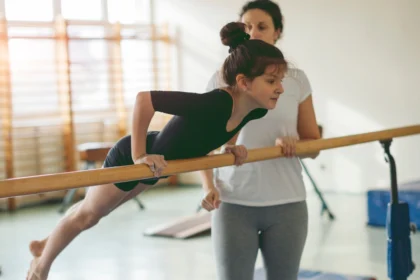The “belly beat,” also known simply as “beats” or “beating the bar,” is a historical skill in gymnastics, specifically performed on the uneven bars.
This skill involved a gymnast swinging from a handstand position on the high bar and forcefully hitting their hips against the low bar to gain momentum for subsequent moves.
Contents
Historical Context and Evolution
In the early days of women’s gymnastics, the uneven bars were set much closer together than they are today. The bars were typically positioned only about half a gymnast’s body length apart, allowing gymnasts to span both bars simultaneously.
The close setup of the bars allowed for various “wrapping” skills. Gymnasts would use their hips and body to make contact with the low bar, generating momentum for their routines.
Notable Performers
The belly beat was a skill performed by several notable gymnasts in the past, particularly during the 1970s and early 1980s:
- Nadia Comăneci: Nadia Comăneci, the famous Romanian gymnast, often performed the belly beat in her routines. She is well-known for earning perfect 10 scores at the 1976 Montreal Olympics. Her routines made the most of the close set bars, including moves like the belly beat.
- Olga Korbut: Another gymnast who performed the belly beat was Olga Korbut, known as the “Sparrow from Minsk.” Competing for the Soviet Union, she was instrumental in popularizing dynamic bar routines in the early 1970s. Her innovative and daring performances made her a standout at the 1972 Munich Olympics.
- Ludmilla Tourischeva: Ludmilla Tourischeva, another Soviet gymnast, also performed the belly beat. Competing in the same era as Olga Korbut, Tourischeva was known for her powerful and precise gymnastics, playing a significant role in the evolution of uneven bar routines.
Execution of the Belly Beat
Here’s a step-by-step guide to performing the belly beat:
- Starting Position: The gymnast begins in a handstand on the high bar, ensuring proper alignment and stability.
- Swing Initiation: By slightly arching the back and engaging the shoulders, the gymnast initiates a swing, moving downward toward the low bar.
- Hip Contact: As the swing progresses, the gymnast allows their hips to make contact with the low bar, specifically at the point where the body bends at the waist, not on the hip bones, to avoid pain and injury.
- Momentum Generation: The impact with the low bar provides additional momentum, aiding in the execution of the next skill or movement.
- Transition: Utilizing the generated momentum, the gymnast transitions smoothly into the next element of their routine, whether it’s another swing, a release move, or a transition back to the high bar.
Is Belly Beat a Dangerous Move?
The belly beat, or “beating the bar,” is indeed considered a dangerous move in gymnastics. Several factors contribute to the inherent risks associated with this skill:
1. Impact on the Hips and Abdomen
The belly beat involves a gymnast swinging from the high bar and forcefully hitting their hips against the low bar. If executed incorrectly, the impact can cause significant bruising, hip rips, or even more serious injuries like fractures. Gymnasts often experienced deep bruises or abrasions, especially on the hips, due to the direct force of the move.
- The risk increases when gymnasts make contact with their hip bones rather than the fleshy part of the hips, leading to painful consequences.
- The force of the hip impact can also lead to injury in the lower abdomen and lower back.
2. Precision and Timing Requirement
The belly beat requires perfect timing and precision. The gymnast must ensure that their body swings in such a way that the impact occurs at the correct location—where the waist bends, not at the hip bones. This is crucial for avoiding injury, but even slight miscalculations in timing or positioning can lead to painful consequences.
- If the gymnast misjudges the swing or the bar is not set at the proper distance, they may land on the bars in a way that causes greater impact and injury.
3. Increased Risk with Incorrect Bar Setup
The safety of the belly beat also depends on the distance between the bars. During the time the belly beat was popular, the bars were typically set closer together, which made the skill easier and safer to execute. However, when the bars were moved further apart in the mid-1980s, this change made it more difficult and dangerous to perform the belly beat.
- A wider bar setup increased the likelihood of the gymnast swinging at an incorrect angle or missing the low bar entirely, which could lead to falls or other types of injury.
Why the Belly Beat is Gone?
While visually striking and once popular, the belly beat is no longer a part of contemporary gymnastics.
1. Wider Bar Settings
In the mid-1980s, the uneven bars were redesigned with wider spacing between them. Previously, the bars were set much closer together, allowing gymnasts to perform moves like the belly beat, where they could span both bars simultaneously and use their hips to generate momentum.
With the new wider setup, the dynamics of performing the belly beat became much more difficult and impractical. The gymnast would have to stretch more to make the impact on the low bar, which added more risk to the move, making it harder to execute safely.
2. Changes in Scoring and Judging Criteria
Modern gymnastics places a greater emphasis on precision, execution, and safety when scoring routines. Skills that posed a high risk of injury, like the belly beat, were no longer favored because they did not align with the goals of contemporary gymnastics.
Judges and gymnastics authorities like the FIG (Fédération Internationale de Gymnastique) have increasingly focused on moves that offer high points while minimizing the likelihood of injuries.
3. Athlete Safety as a Priority
As the sport evolved, gymnastics organizations placed a higher priority on athlete safety. While the belly beat may have been a visually striking move in its time, the risks of injury—especially to the hips, back, and abdomen—became unacceptable.
As more safety regulations were introduced, high-risk skills like the belly beat were discouraged, and gymnasts were encouraged to perform moves that maintained high difficulty levels without endangering their well-being.
What Replaced the Belly Beat?
The belly beat in gymnastics was replaced by several new, safer, and more dynamic skills that better aligned with the evolution of the sport. These skills offered the same benefits—such as generating momentum for subsequent moves—without the high risk of injury associated with the belly beat. Here are the key skills and techniques that replaced the belly beat:
1. Release Moves
One of the major replacements for the belly beat is release moves. These moves became popular after the bar distance was widened and gymnasts started focusing on more complex aerial elements. Release moves are visually impressive, help generate momentum, and are much safer than the belly beat because they avoid the risk of direct impact with the bar.
Some popular release moves include:
- Gienger: A release move in which the gymnast performs a backward somersault after letting go of the bar, then re-grips the bar in a controlled manner.
- Jaeger: A move where the gymnast releases the bar, flips backward in the air, and re-grips the bar.
- Kovacs: A release move where the gymnast swings, releases the bar, and performs a backflip in the air before re-gripping.
These moves added difficulty and excitement to routines while significantly reducing the risk of injury compared to the belly beat.
2. Giant Swings
The giant swing is another skill that has replaced the belly beat. This skill involves swinging around the bar in a circular motion while the gymnast’s body is fully extended. Giant swings provide a powerful momentum that allows the gymnast to perform other skills, such as pirouettes or dismounts, with smooth transitions.
- Giant swings are a safer alternative to the belly beat because they don’t involve direct impact with the low bar. Instead, gymnasts rely on momentum and control to execute the move smoothly.
3. Aerial Transitions and Complex Twists
With the new bar setup, gymnasts began performing aerial transitions, which involve moving fluidly from one bar to the other without hitting the low bar with their body. These transitions often incorporate twists and somersaults, showcasing the gymnast’s ability to maintain control during mid-air movements.
In summary, modern gymnastics places a greater emphasis on fluidity and precision in bar routines. Rather than relying on a risky hip impact, gymnasts now perform fluid transitions between moves. The belly beat has been replaced by more dynamic, safer, and visually impressive skills that align with the evolution of the sport.












